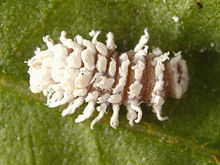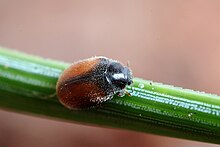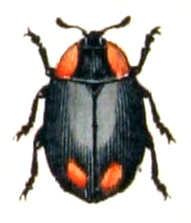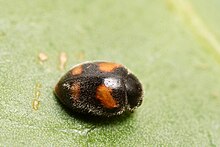Scymnini
| Scymnini | ||||||||||||
|---|---|---|---|---|---|---|---|---|---|---|---|---|

Black ball ladybug ( Stethorus punctillum ) |
||||||||||||
| Systematics | ||||||||||||
|
||||||||||||
| Scientific name | ||||||||||||
| Scymnini | ||||||||||||
| Mulsant , 1850 |










The Scymnini are a tribe within the ladybirds (Coccinellidae). This group includes many small species, which in German are often referred to as dwarf ladybirds .
features
Beetle
The adult beetles of the Scymnini are small, typically one to two millimeters long. Their body is hemispherical and almost always covered with thick hair. Only a few species have a smooth and shiny back surface. Many species can be identified by their characteristic drawing, but their variability and small size usually require examination under the microscope .
Like the Chilocorini, the Scymnini have their heads retracted far below the prothorax (pronotum). Their very short antennae are built differently and have a reduced number of links. The Chilocorini differ from the Scymnini in that the face plates ( clypeus ) are greatly enlarged at the sides . The end link of the upper button is not clearly triangular in shape as in most of the other tribe of ladybugs.
Larvae
The larvae of the Scymnini secrete a waxy substance that covers their body. The only exceptions are the species of the genus Stethorus that do not have such wax formations. On the other hand, there are also wax coatings on the larvae of other tribe of ladybirds, e.g. B. with the Coccidulini and Chilocorini.
Way of life and distribution
The species of the Scymnini tribe are common worldwide. They feed on spider mites , thyroid and Motte scale insects , as well as aphids . The beetles lay their eggs on leaves that are infested with lice or mites. These not only serve as food for the beetles but also for their predatory larvae.
Systematics
For a long time, the Scymnini were regarded as one of the numerous subfamilies of the ladybirds under the name Scymninae. In 2007, Adam Ślipiński proposed a new system that only contains two subfamilies. According to this system, the Scymnini belong as a tribe to the subfamily Coccinellinae . The internal and external systematics of the Scymnini within this new subfamily must be examined more closely. Preliminary molecular biological work has shown that the family is likely paraphyletic .
Genera and some selected species of Scymnini:
- Acarinus
- Aspidimerus
- Cryptogonus
- Pseudaspidimerus
-
Stethorus
- Black ball ladybug ( Stethorus punctillum )
- Parastethorus
- Acoccidula
- Aponephus
- Apseudoscymnus
- Axinoscymnus
-
Clitostethus
- Bow dwarf ladybug ( Clitostethus arcuatus )
-
Cryptolaemus
- Australian ladybird ( Cryptolaemus montrouzieri )
- Cycloscymnus
- Cyrema
- Depressoscymnus
- Didion
- Geminosipho
- Horniolus
- Keiscymnus
- Leptoscymnus
- Midus
- Nephaspis
-
Nephus
- Subgenus Bipunctatus (9-part antennae)
- Two Punk Tiger dwarf Ladybug ( Nephus (bipunctatus) bipunctatus )
- Zweifleckiger dwarf Ladybug ( Nephus (bipunctatus) bisignatus )
- Subgenus Nephus (11-part antennae)
- Vierfleckiger dwarf Ladybug ( Nephus (Nephus) quadrimaculatus )
-
Redtenbacher dwarf Ladybug ( Nephus (Nephus) redtenbacheri )
- Beach dwarf Ladybug ( Nephus (Nephus) redtenbacheri limonii )
- Subgenus Sidis (10-part antennae)
- Nephus anomalus ( Nephus (Sidis) anomalus )
- Nephus horioni ( Nephus (Sidis) horioni )
- Nephus kahleni ( Nephus (Sidis) kahleni )
- Subgenus Bipunctatus (9-part antennae)
- Parascymnus
- Parasidis
- Propiptus
- Sasaji symnus
- Scymniscus
- Scymnobius
- Scymnodes
- Scymnomorpha
-
Scymnus
- Subgenus Mimopullus
- Scymnus fennicus ( Scymnus (Mimopullus) fennicus )
- Scymnus flagellisiphonatus ( Scymnus (Mimopullus) flagellisiphonatus )
- Scymnus fulvicollis ( Scymnus (Mimopullus) fulvicollis )
- Scymnus mediterraneus ( Scymnus (Mimopullus) mediterraneus )
- Scymnus sacium ( Scymnus (Mimopullus) sacium )
- Subgenus Neopullus
- Black Pygmy Ladybug ( Scymnus (Neopullus) ater )
- Small red-bodied dwarf ladybug ( Scymnus (Neopullus) haemorrhoidalis )
- Willow pygmy ladybug ( Scymnus (Neopullus) limbatus )
- Silesian dwarf ladybug ( Scymnus (Neopullus) silesiacus )
- Subgenus Parapullus
- Spruce ball ladybug or spruce dwarf ladybug ( Scymnus (Parapullus) abietis )
- Subgenus Pullus
- Red-edged dwarf ladybug ( Scymnus (Pullus) auritus )
- Large red-bodied dwarf ladybird ( Scymnus (Pullus) ferrugatus )
- Oblique-banded dwarf ladybug ( Scymnus (Pullus) subvillosus )
- Fir pygmy ladybug ( Scymnus (Pullus) impexus )
- Striped pine dwarf ladybug ( Scymnus (Pullus) suturalis )
- Subgenus Scymnus
- Southern dwarf ladybird ( Scymnus (Scymnus) apetzi )
- Dark-thighed dwarf ladybug ( Scymnus (Scymnus) femoralis )
- Dry grass dwarf ladybird ( Scymnus (Scymnus) frontalis )
- Tansy pygmy ladybug ( Scymnus (Scymnus) interruptus )
- Similar pygmy ladybug ( Scymnus (Scymnus) mimulus )
- Black pine dwarf ladybug ( Scymnus (Scymnus) nigrinus )
- Unrecognized dwarf Ladybug ( Scymnus (Scymnus) pallipediformis apetzoides )
- Hop dwarf ladybird ( Scymnus (Scymnus) rubromaculatus )
- Subgenus Mimopullus
- Veronicobius
- Decadiomus
- Diomus
- Heterodiomus
- Magnodiomus
- Erratodiomus
- Viridigloba
- Zagloba
- Zilus
- Selvadius
- Blaisdelliana
- Corystes
- Helesius
- Hyperaspidius
-
Hyperaspis
- Spotted short-horned ladybird ( Hyperaspis campestris )
- Monochrome short-horned ladybird ( Hyperaspis concolor )
- Günther's short-horned ladybird ( Hyperaspis inexpectata )
- Shoulder- spotted short-horned ladybird ( Hyperaspis pseudopustulata )
- Reppen's ball beetle or spotted short-horned ladybird ( Hyperaspis reppensis )
- Thalassa
- Tiphysa
- Brachiacantha
- Cyra
- Hinda
- Calloe ice cream
- Curticornis
- Pentilia
- Cryptognatha
supporting documents
Individual evidence
- ^ Bernhard and Hertha Klausnitzer: Ladybirds . Die Neue Brehm-Bücherei Volume 451, Westarp Wissenschaften, 4th edition, Magdeburg 1997, page 85
- ↑ Adam Ślipiński: Australian Ladybird Beetles (Coleoptera: Coccinellidae) their Biology and Classification. ABRS, Australian Biological Resources Study, Canberra 2007 ISBN 978-0-642-56855-7
- ^ Richard AB Leschen, Rolf G. Beutel, John F. Lawrence: Handbuch der Zoologie - Coleoptera, Beetles, Volume 2: Morphology and Systematics (Elateroidea, Bostrichiformia, Cucujiformia partim) . de Gruyter, 2010, ISBN 978-3-11-019075-5 (English).
- ↑ Nephus identification key for Beetles of Europe
- ↑ Scymnus identification key in European beetles
literature
- Johann Gottlieb Kugelann : Directory of the species of beetles that have been discovered in some areas of Prussia, together with brief reports of them. Latest magazine for lovers of entomology, 1, 5, pp. 513-582, 1794 (first description)
- A. Ślipiński & W. Tomaszewska: Coccinellidae (Coleoptera). In: Richard AB Leschen, Rolf G. Beutel, John F. Lawrence, NP Kristensen (Eds.): Handbook of Zoology. Arthropoda, Insecta, Coleoptera, Vol. 2. pp. 454-472, Walter de Gruyter, Berlin, New York 2010
Web links
- Scymninae at Fauna Europaea